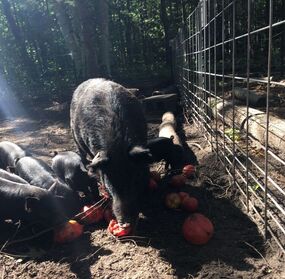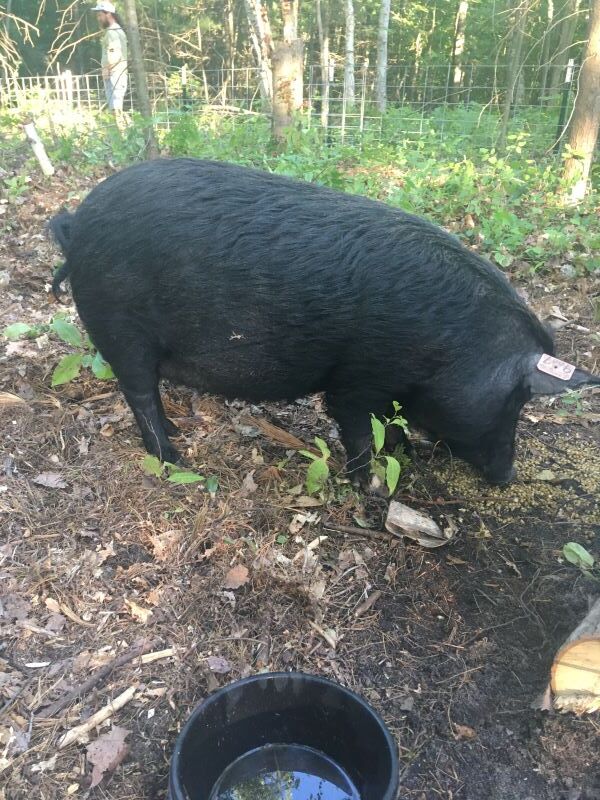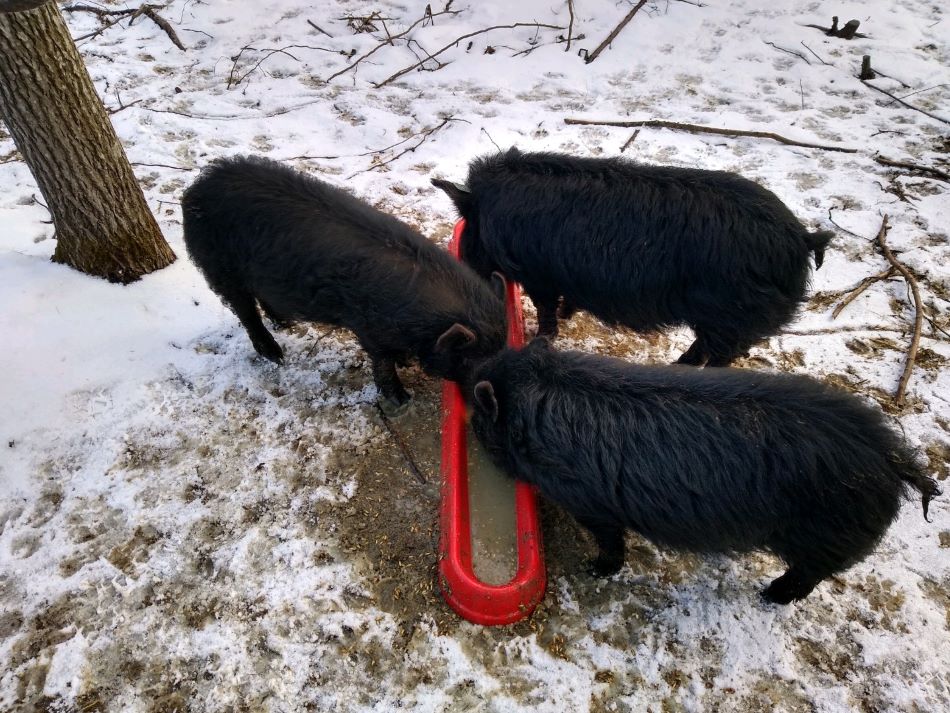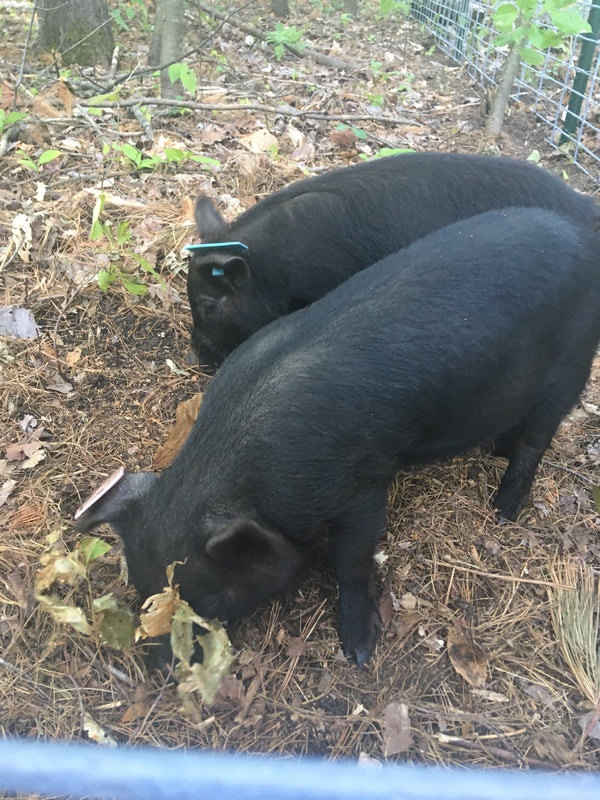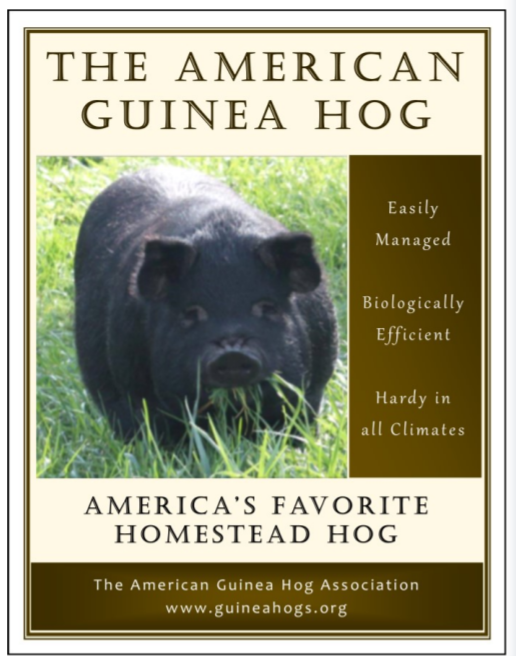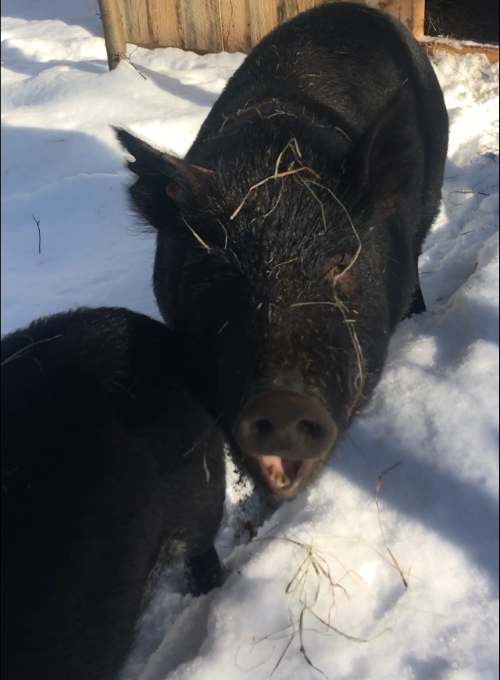Our Story
Forest restoration. Ethical meat consumption. Compost. Those were our needs. The next farm plateau to reach, and a lofty one at that. An easy way to solve all three? Hogs. A breed that meets the needs of all three of those goals, but also matches our farm philosophy and our symbiotic relationship with our animals? Enter American guinea hogs.
Like all farm endeavors, it seems, once we realized our needs, we jumped in without a second thought. First task on the agenda? Research which breed of hogs would be a good fit. So we stumbled down the rabbit hole of hog ideologies as we did our reading on hog breeds. Through this process, one breed in particular stayed toward the top of our list: The American guinea hog.
The information that we learned about AGHs was unequivocally positive:
Are American guinea hogs easy to care for on the farm?
They reach a manageable weight, full grown, at around 200 pounds. Wild foraging, they are great on the pocketbook and more suitable to a forest that has lots of tree brush, nuts and seeds, plant life, and root tubers. That's why they are often referred to as piney woods hogs, we would come to realize.
What about their personalities? We love our animals here at Heart's Pasture, and bonding with them is important to us, even if one day they do become our respective dinner. It is important that we give them what they need to subsists, but that we also meet their social needs and give them a life well-lived.
AGHs have great personalities! They are docile, and have the ability to form a unique attachment to their farmers, food motivated as it may be. Boars are very trainable and will take pets and rubs just as much as a gilt, sow, or barrow. Sows, in particular, have exceptional personalities in regards to rearing piglets. They are generally more gentle and rarely, for example, accidentally crush newborn piglets by rolling over on them (in comparison of more conventional hog breeds). Typically great mothers, they care for their young and teach them the "ways of the hog".
Being human omnivores who love the taste and nourishment of ethically raised and pastured meat, can they feed our farm family (we work hard and eat A LOT)?
Reaching a healthy weight of about 200 pounds full grown, a few hogs each year may be enough to provide a small family their need for pork. How many hogs it takes to feed a family is different for everyone. In addition to prime cuts of meat, American guinea hogs are known to have a large amount of lard, which can be used to make pie crusts, fry eggs in the cast-iron skillet, and make candles or soaps, to mention just a few uses. Their size makes them manageable for socially responsible butchering right on the farm. But lastly, the taste . . . when raised responsibly, heritage breeds have an "old timey" flavor to them, unlike anything a person would buy at the grocery store. American guinea hogs, with all of their wonderful flavors, give conventionally farmed and bred breeds a bad name (and rightfully so).
But would these hogs be a good fit for our northern Michigan setting? Particularly, how would they fair in the winter?
These hogs are incredibly resilient in all settings. Left to forage on their own, they will make do. During our research, we read numerous stories from many decades ago about how these hogs were released on woodland pasture, forgotten, and then found again, healthy as ever, and ready to butcher. Perhaps that is a bit drastic of a way to raise a farm animal, but it definitely is a testament to their genetics, having retained a lot of traits of heartiness from their wild boar relatives. The same could not be said about conventional hog breeds, which have had these traits bred out of them in order to emphasize other parts of their genetic makeup. Thus, if given adequate enough of a shelter, they definitely could thrive in our Michigan climate.
I need something that HEATS UP our compost pile. Every farm, especially one with goats, has a lot of hay waste. Do they fit the bill?
Taken from the book Small Scale Pig Raising, hog manure is as "Good as it stinks". Enough said.
American guinea hogs, once thought to be almost extinct, epitomize the old fashioned, "old timey" homestead hog. Their genetic makeup as a incredibly productive and easy to raise landrace breed deserves attention from all small homesteads. It is by working with this breed of hog that families can become more self-reliant and less dependent on meat that is consumed from the grocery store, flown or driven from thousands of miles away, raised in terrible living quarters, and, we would learn through our reading, perhaps most importantly, not allowed to express its full "pig-ness".
That was the year we started raising American guinea hogs.
Like all farm endeavors, it seems, once we realized our needs, we jumped in without a second thought. First task on the agenda? Research which breed of hogs would be a good fit. So we stumbled down the rabbit hole of hog ideologies as we did our reading on hog breeds. Through this process, one breed in particular stayed toward the top of our list: The American guinea hog.
The information that we learned about AGHs was unequivocally positive:
Are American guinea hogs easy to care for on the farm?
They reach a manageable weight, full grown, at around 200 pounds. Wild foraging, they are great on the pocketbook and more suitable to a forest that has lots of tree brush, nuts and seeds, plant life, and root tubers. That's why they are often referred to as piney woods hogs, we would come to realize.
What about their personalities? We love our animals here at Heart's Pasture, and bonding with them is important to us, even if one day they do become our respective dinner. It is important that we give them what they need to subsists, but that we also meet their social needs and give them a life well-lived.
AGHs have great personalities! They are docile, and have the ability to form a unique attachment to their farmers, food motivated as it may be. Boars are very trainable and will take pets and rubs just as much as a gilt, sow, or barrow. Sows, in particular, have exceptional personalities in regards to rearing piglets. They are generally more gentle and rarely, for example, accidentally crush newborn piglets by rolling over on them (in comparison of more conventional hog breeds). Typically great mothers, they care for their young and teach them the "ways of the hog".
Being human omnivores who love the taste and nourishment of ethically raised and pastured meat, can they feed our farm family (we work hard and eat A LOT)?
Reaching a healthy weight of about 200 pounds full grown, a few hogs each year may be enough to provide a small family their need for pork. How many hogs it takes to feed a family is different for everyone. In addition to prime cuts of meat, American guinea hogs are known to have a large amount of lard, which can be used to make pie crusts, fry eggs in the cast-iron skillet, and make candles or soaps, to mention just a few uses. Their size makes them manageable for socially responsible butchering right on the farm. But lastly, the taste . . . when raised responsibly, heritage breeds have an "old timey" flavor to them, unlike anything a person would buy at the grocery store. American guinea hogs, with all of their wonderful flavors, give conventionally farmed and bred breeds a bad name (and rightfully so).
But would these hogs be a good fit for our northern Michigan setting? Particularly, how would they fair in the winter?
These hogs are incredibly resilient in all settings. Left to forage on their own, they will make do. During our research, we read numerous stories from many decades ago about how these hogs were released on woodland pasture, forgotten, and then found again, healthy as ever, and ready to butcher. Perhaps that is a bit drastic of a way to raise a farm animal, but it definitely is a testament to their genetics, having retained a lot of traits of heartiness from their wild boar relatives. The same could not be said about conventional hog breeds, which have had these traits bred out of them in order to emphasize other parts of their genetic makeup. Thus, if given adequate enough of a shelter, they definitely could thrive in our Michigan climate.
I need something that HEATS UP our compost pile. Every farm, especially one with goats, has a lot of hay waste. Do they fit the bill?
Taken from the book Small Scale Pig Raising, hog manure is as "Good as it stinks". Enough said.
American guinea hogs, once thought to be almost extinct, epitomize the old fashioned, "old timey" homestead hog. Their genetic makeup as a incredibly productive and easy to raise landrace breed deserves attention from all small homesteads. It is by working with this breed of hog that families can become more self-reliant and less dependent on meat that is consumed from the grocery store, flown or driven from thousands of miles away, raised in terrible living quarters, and, we would learn through our reading, perhaps most importantly, not allowed to express its full "pig-ness".
That was the year we started raising American guinea hogs.
Our Foragers: American Guinea Hogs
Here at Heart's Pasture in beautiful northern Michigan, we have a small herd of American Guinea Hogs. In the spring, summer, and fall they enjoy rooting for tubers (roots of plants), eating fallen leaves, and munching on acorns or beech nuts! They are remarkably well tempered and are around 200 pounds when they reach maturity. This makes AGHs a perfect homestead hog. They are easy to move around, easy to care for, and extremely easy going! Our hogs get to live their best lives just being hogs. This means that, in addition to plenty of fresh water and a sturdy shelter, they receive:
|
|
Get to Know our Hogs:
